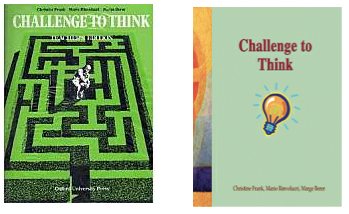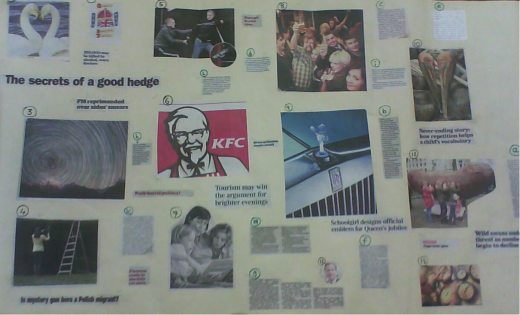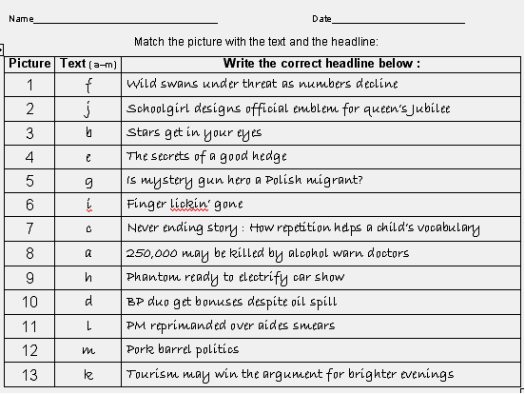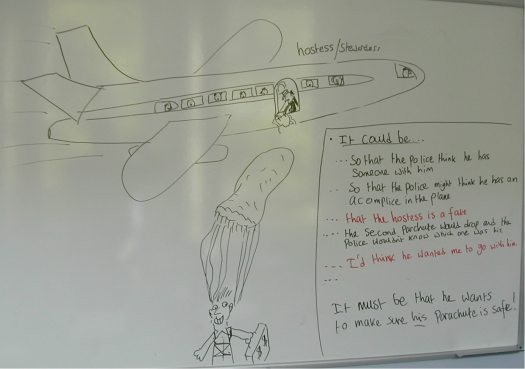Some Old Exercises From "Challenge to Think"
Peter Clements, UK
Peter Clement’s main work is teaching ESOL Adult and Community Learning in the UK. There is always a lot to cover in his classes including citizenship content and preparation for the Trinity Skills for Life ESOL exams. Individual targets are also negotiated with students for their Individual Learning Plans which are reviewed at regular intervals. So all of this keeps him and his students pretty busy, but thankfully, not so busy that they don’t have time for some fun and spontaneity in class. With that in mind, he has compiled the following article for ‘An Old Exercise’ based on experiences using the excellent book ‘Challenge to Think’. He lives on the coast with his wife and son near Canterbury, UK, and his other interests include cycling, enjoying jazz and occasionally blowing the dust off his guitar.
E-mail: peter.clements@talktalk.net

Menu
Introduction
Puzzle stories
Matchings
Two-In-One Stories
Deduction Puzzles
Conclusion
Further examples from the book
See also
I first saw an old and well-worn copy of this publication on the resource shelves while teaching on adult intensive classes at a school of English in Canterbury last year. Being pleased with the way the activities and approaches were received in class, I was then fortunate to get hold of an old copy myself, albeit the student version - without answers – so I had the great challenge of thinking too (thankfully I have recently managed to obtain a copy of the teacher version)! There are so many great activities in this book, which in addition to language stimulates the thinking process and enhances creativity and imagination.
‘Aim: Practice in asking correct questions. Students are given an unexplained story. By asking a large number of questions, they eliminate wrong and irrelevant explanations of the story and find out what it is really about.’
The aim of these activities is to generate curiosity and prompt speculation and hypothesis about seemingly impossible or unlikely situations using so-called ‘lateral thinking’. Being presented with an unlikely or bizarre scenario, students have to ask questions in order to solve the mystery. The teacher or another person who holds the solution is allowed to answer simply ‘yes’, ‘no’ (and the occasional ‘It doesn’t matter' or ‘ask me differently’).
Example from the book: ‘Two men look up around a corner and see something that makes them want to go down.’
Here is a typical line of reasoning:
Q. Were the two men in the street?
A. No.
Q. Were they in a building?
A. No
Q. Were they inside somewhere?
A. Yes.
Q. Were they in a lift?
A. No
Q. Were they in a tower?
A. (hesitantly) er….No
Q. Was it a vehicle?
A. Yes
Q. A car? A bus?
A. No.
Q. A lorry?
A. No
Q. A boat, a ship?
A. Yes, Yes!
Q. A cargo ship?
A. No.
Q. A passenger liner?
A. No
Q. A warship?
A. Yes…sort of…
Q. What kind? A destroyer?
A. No.
Q. A boat that goes under the sea?
A. Yes – A submarine.
Q. ‘They looked up ...around a corner’? I know! They looked through one of those…
A. Yes…?
Q. One of those things and saw something on the water….
A. Yes…
Q. ….it was an enemy boat and they needed to go down below the water.
T. That’s it! They were looking through the periscope of their submarine.
Black Stories and Lateral Thinking Puzzles
This activity worked extremely well with a class of advanced Austrian students last summer. German speakers are familiar with a card game called ‘Black Stories’ by Holger Bösch where the stories are presented in the form of a pack of cards.
After presenting a couple of examples from ‘Challenge to Think’, the students wished to continue with examples they knew themselves. This gave the students complete ownership of the lesson and was enjoyable and highly productive as they were really able to engage their English skills.
In English, these stories have long been known as ‘Lateral Thinking Puzzles’ and numerous additional examples can be found on the internet. For some reason, their content is usually of a rather morbid nature. |
‘Aim: For discussion of the meaning of newspaper headlines and captions, and speculation about what the accompanying articles or cartoons are about. Followed by fast reading of the actual articles to match them to the headlines’
This is a versatile activity included in the ‘Reading and Speaking’ section of the book. Typically, on one page, there is a collection of headlines with their corresponding short articles or a section of an article on the other.
Having the 1983 impression of the book, naturally the articles appear dated and some of the language is outdated (e.g.: ‘Mr. Hart’s car – A black Granada’, * mentally handicapped children, President Mitterrand’s election programme, Kenneth Clarke –transport spokesman etc…) so I chose to adapt and simplify the idea for my pre-intermediate/ Entry 3 ESOL class. and used recent examples of newspapers cut and pasted onto an all -in - one poster using a headline, a short snippet of text and a picture from an article to make up a three-way matching exercise. Below is a photo of the poster and the activity sheet that was used in class.
This could be done more interactively of course, by bringing in a bundle of newspapers and having the students make their own versions in groups and to then exchange them. They don’t even need the printed sheet but could simply draw their own table. In hindsight, the students would have benefited more had they read the headlines first and had time to speak and speculate as to the meaning before reading the short articles ( this is the procedure recommended in the book).
The rich variety of language peculiar to headlines and the visual element is intriguing to students at different levels.


‘Aim: An Intensive reading exercise. The lines of two stories are mixed together out of sequence. Students must separate and sequence the stories. They then tell each other the stories from memory’
This activity is a lot of fun for students and beneficial in so many different ways. The stories, found in the ‘Reading and Speaking’ section of the book are amusing and instructive, usually with a bit of a twist or a punch line at the end. I have used one of the less challenging ones with some students in an elementary class (The Railway Ticket / Aesop’s Fable) and others both in pre-intermediate and higher level classes.
The activity involves separating out two stories and then re-ordering the sentences. Often familiar with the structure of a story, students usually find the first sentence of each one with relative ease. Then, using contextual clues and key words, they can usually separate the content into two distinct stories. It is interesting too note how they approach the task – some students are well organised and may mark the sentences with a symbol or A and B to indicate which sentence belongs to which story; others may need some more detailed input beforehand as to how to proceed. Then, the students may use a numbering system to indicate the order in which the sentences are placed. (For the less able, it may be an idea to issue the students with scissors to cut the sentences into strips).
The desired outcome is for students to re-tell the stories from memory but at pre-intermediate equivalent ESOL students, to have been able to re-order the separate stories and then to have read them, was in itself a worthwhile achievement.
In the example of ‘Aesop’s Fable’ (Sometimes known as ‘The Travellers and the Monk’) the ordering is complicated by the element of repetition, a common feature of story telling. This can throw the students initially and provides good opportunities for applying reasoning and how the apparent repetition is used for effect but with appropriate markers to indicate where the sentence appears in the narrative, e.g.:
Aesop replied, ‘Tell me where you are from and what sort of people live there, and I’ll tell you what sort of people you’ll find in Athens.’
Again Aesop replied, ‘Tell me where you are from and what sort of people live there, and I’ll tell you what sort of people you’ll find in Athens.’
Also, the way in which phrases are used to contrast similar situations is typical of stories. For example, in replying to the two travellers, one with a positive attitude, the other negative, Aesop’s replies are similar but in a way that after careful reading becomes apparent:
At this Aesop answered, ’I’m happy to tell you, my dear friend, that you’ll find the people of Athens much the same.’
‘I’m afraid you’ll find the people of Athens much the same,’ was Aesop’s reply.’
My favourite example of a two- in- one story from is: The farmer / The invitation and depends on students being able to consider other lesser used meanings of verbs to make sense.
- ‘Well,’ said the farmer, scratching his chin, ‘I’ll tell you what we do.’
- ‘Why do I have to use my elbow and my foot?’ asked his friend.
- A man inviting his friend to his home explained to him where he lived.
- The man went back to his car with a puzzled look on his face and said to his wife, ‘I think he must be crazy.’
- ‘Come to the third floor,’ he said,’ and where you see the letter E on the door, push the button with your elbow and when the door opens put your foot against it.’
- ‘We eat what we can and what we can’t eat we can.’
- A curious tourist, after passing a huge field of carrots alongside the road, stopped and asked the farmer what he did with his large crop.
- ‘He said they ate what they could and what they couldn’t they could.’
- ‘Well,’ exclaimed the man, ‘You’re not going to come empty handed are you?’
When using this with the advanced Austrian class, no explanation was necessary, they were able to retell the stories with ease and the humourous aspect of the tourist’s bewilderment was immediately obvious. However, with lower level groups some elicitation was necessary including sketching a labelled cylindrical object on the board to indicate the process to which the farmer was referring with the present simple ‘can’.
(See also Eric K. Taylor Using Folktales Cambridge Handbooks for Language Teachers)
“Aim: Intensive reading practice and oral practice of a range of conditionals and deductive language. Students read a story which poses a problem and answer questions which lead to the solution.”
These are used in a similar way to the ‘Puzzle Stories’ above but this time the students are provided with clues in the form of questions that prompt reasoning which leads to the solution. Some of the puzzles (‘The Lawyers’ ‘The Scientists and the Watches’ and ‘Four Women’) do not have definitive answers but provide a good opportunity for discussion about the logic or likelihood of the situation.
As before, the students are presented with a puzzle, which is rather more convoluted and which requires very careful reading and analysis. The students then speculate and some will even make wild guesses as to possible solutions. This presents a good opportunity for speaking in groups but the students are unlikely to come up with the solution on their own.
The teacher can then either issue the series of written questions or read them out gradually and which will lead the students to apply logical deductive skills to eventually converge on the answer. The questions help them to imagine they are faced with dilemma and that they are in the situation themselves.
‘The Two Parachutes’ is a good example of this type of puzzle and is reproduced below as it is presented in the book with the questions:
“Not long ago a man kidnapped a little boy and hid him in the woods. He sent his parents a ransom note telling them to leave him ten thousand pounds in an airport locker. They were then to wait four hours and go to the locker. In it they would find directions to where their child was. He said that unless they left him the money, they would not see their child for a long time.
He had thought of taking the child with him as a hostage, but decided against it. He knew that the police had become good at trapping people who had hostages with them.
At the appointed time, he went to the airport and found the money in the locker. He had just enough time to leave the directions and run. The police were close behind him. He boarded the nearest plane and forced the pilot to take off before he was caught.
Knowing that the police would be waiting for him when the plane landed, he came up with a brilliant idea to save himself. He demanded that the hostess should give him two parachutes. He took her with him to the back exit door of the plane and waited several minutes. Then he put one of the parachutes on and jumped alone from the plane. In this way he managed to escape.
The question is, why did he demand two parachutes?
A board – drawn version of the illustration from the book, used with a group of advanced Austrian students in 2010, is shown below. The comments on right are actual student answers.

- What would’ve happened if he’d stayed on the plane?
- Did he have a chance of escaping if he jumped safely?
- Did he have a better chance of escaping if he had a hostage with him?
- Why?
- Say you were the hostess. If he he’d asked you for two parachutes and taken you with him to the exit door, what would you have thought?
- What kind of parachutes would you have given him?
- Why?
In this example the questions lead to one definite right answer whereupon the student will experience that wonderful ‘aha! moment’ which is immensely satisfying for them (and the teacher!).
One of the other problems requires some simple maths along with logic (The Sultan and the Cheat) and spatial and visualisation skills are stimulated by ‘The Prisoners’ and ‘Four women’.
‘Challenge to Think’ is a classic EFL book that is worth its weight in gold. There are so many other excellent activities contained within its pages – far too many to go into here. It would be so good for publishers to realise its value for today and to make a new edition available, with some updated photos and new newspaper extracts. Come on you publishers!
Puzzle Stories old.hltmag.co.uk/nov99/ex.htm
Two in One Stories old.hltmag.co.uk/sep02/ex.htm
Deduction Puzzles old.hltmag.co.uk/aug99/ex.htm
Black stories
http://ludolingua.de/wp-content/uploads/2007/05/black_stories_en.pdf
More lateral thinking puzzles
www.rinkworks.com/brainfood/p/latreal1.shtml#p_latreal9
http://en.wikipedia.org/wiki/Induction_Puzzles

Please check the Creative Methodology for the Classroom course at Pilgrims website.


|